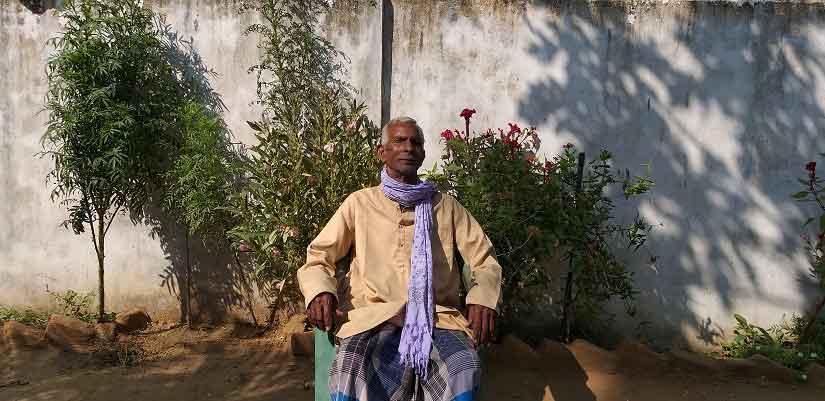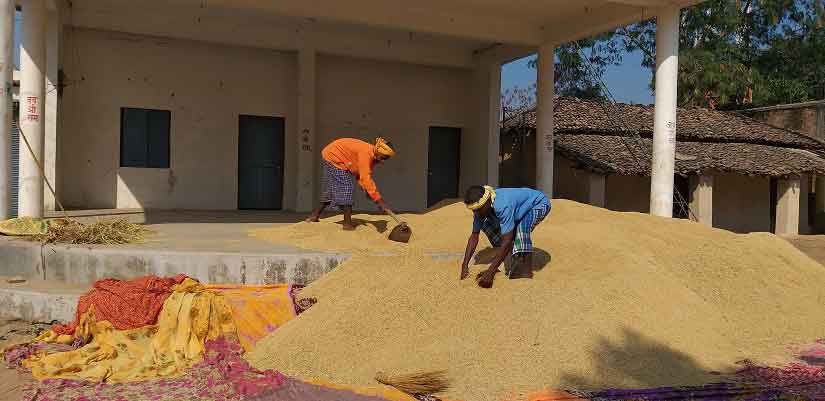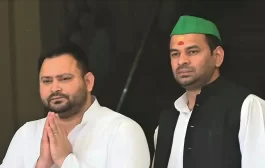All the farmers in the Kurna village of Chhattisgarh’s Kanker district agree on one statement — “We have managed to survive because we installed infrastructure for irrigation in our farms ourselves; we did not wait for the government to provide for us.”
In 2017, the state government had declared 96 tehsils of 21 districts of Chhattisgarh drought-hit. Over 1.1 million farmers were affected by the lack of rainfall in the Kharif season last year, many of whom are still awaiting the amount they were promised under the crop insurance scheme.
In Kurna, one of the villages on the banks of the Mahanadi river in the district’s Narharpur block, around 50 farmers have spent at least Rs 5 lakh from their own pockets to buy equipment for irrigation. This arrangement allows them to make use of their proximity to the vital resource of the river. Some of the farmers invested in a drip irrigation system nearly a decade ago.
Jagguram Sahu, a 78-year-old farmer, says, “I got tired of the government’s excuses for the delay in providing irrigation facilities in our village. Even after putting our demands forward repeatedly, nothing happened. So a few of us decided to get it done ourselves around 10 years ago. The next generation has followed our example.”
Jagguram owns 14 acres and grows only paddy in both the Kharif and Rabi seasons. He is considered one of the ‘big’ farmers in the village, but he vehemently denies that the irrigation system has earned him any real profit.
“I make no extra profit from my yield, even though I am able to grow paddy throughout the year. If we hadn’t put in this system, my family would have probably suffered. So the only benefit is that we have not suffered,” he says.
Mahendra Nishad, 55, breaks down the expenditures involved: “In 2008, I spent a total of Rs 5 lakh on the irrigation system, including a 1.5-kilometre-long pipeline and a water pump, and on its installation. I had to take a loan from the bank. Now I spend on electricity and maintenance; there are also added costs of labour, fertiliser, and manure.”
However, in spite of the expenses and the fact that nearly all farmers are burdened by debt, they are satisfied with their decision.

Toran Maharaj, who owns five acres, says getting their own system installed helped them escape frequent, unfruitful rounds of government offices and allowed them to use good quality equipment.
“Even if the administration had given us equipment for irrigation, its quality would not have matched what we bought. The pipes would have been weak and broken easily,” Maharaj says.
Surjuram Jurree, an Adivasi farmer, is the oldest of five brothers, all of whom depend on a four-acre farm for their livelihood. “If I hadn’t been able to irrigate my land, I would have no choice but to work as a daily-wage labourer,” he says.
In Kurna, farmers have empowered themselves to help each other survive in times of drought like in 2017. The concept of ‘sahyak kisan’, or ‘dependent farmer’, is followed for those who are not able to afford irrigation systems for their land.
Gopiram Sahu is helped by Jagguram, who provides water for at least two acres of Gopiram’s land. “I cannot afford to irrigate my land, so I take help from other farmers. It’s a give and take process. A big farmer provides water for a small farm through equipment used for irrigation, and small farmers work as labourers when they can,” he exlains. “The farming community is finding ways and means to get themselves out of debt without the government’s help.”
Bhanbai Sahu, who is also a dependent farmer, pays a neighbor Rs 2,000 every season to be able to use water from his borewell for her farm. “After our land got divided in the family, my husband and I have one and a half acres to our name. Every season, we have to pay to provide the paddy crop with adequate amount of water,” she says.

Another dependent farmer, Santosh Sahu has not bought equipment for irrigation because he is scared to take a loan that would add to the debt he already has pending. “I have no money to get my land irrigated on my own, and I’m scared to take another loan. Currently, I only take seasonal loans for fertilisers, which is usually Rs 5,000,” he says.
Santosh supplements the income he gets from the three-acre land that is shared by two families by working as a daily-wage labourer. “That money goes towards paying for my children’s education,” he adds.
However, while they agree that the government has failed the agrarian community, big farmers are largely supportive of the BJP for their campaign of vikas (development). “The government has provided free healthcare and rice for Re 1. So the BJP may get more votes than the Congress because the Congress is not entirely trusted,” says Jagguram.
However, Gopiram says farmers needed to move past the ‘party’ mindset. “We also need to evaluate the candidate as an individual and then vote. All parties made big promises before the elections, but who knows what they’ll do once they come to power?” he asks.
The first phase of the Chhattisgarh Assembly elections are underway, including in the Kanker constituency, which includes the Narharpur block. Currently, the Congress party’s Shankar Dhurwa is the MLA from one of three constituencies in the district. For the 2018 Assembly elections, however, the party fielded Shishupal Sori.
source: Firstpost.com







































